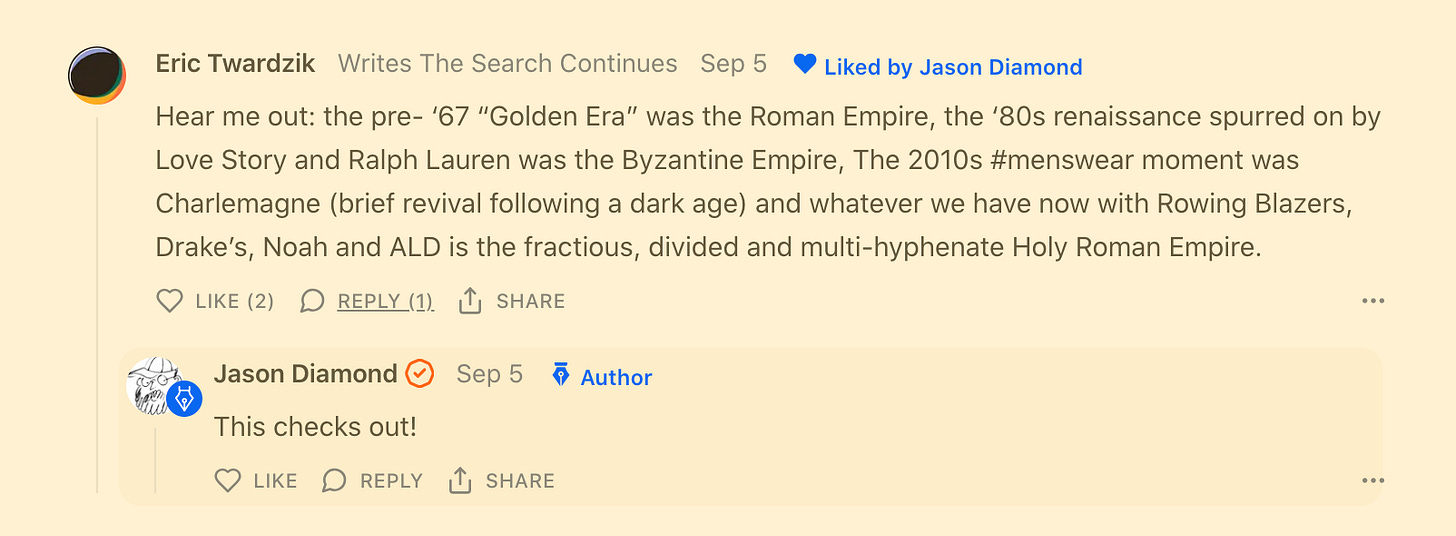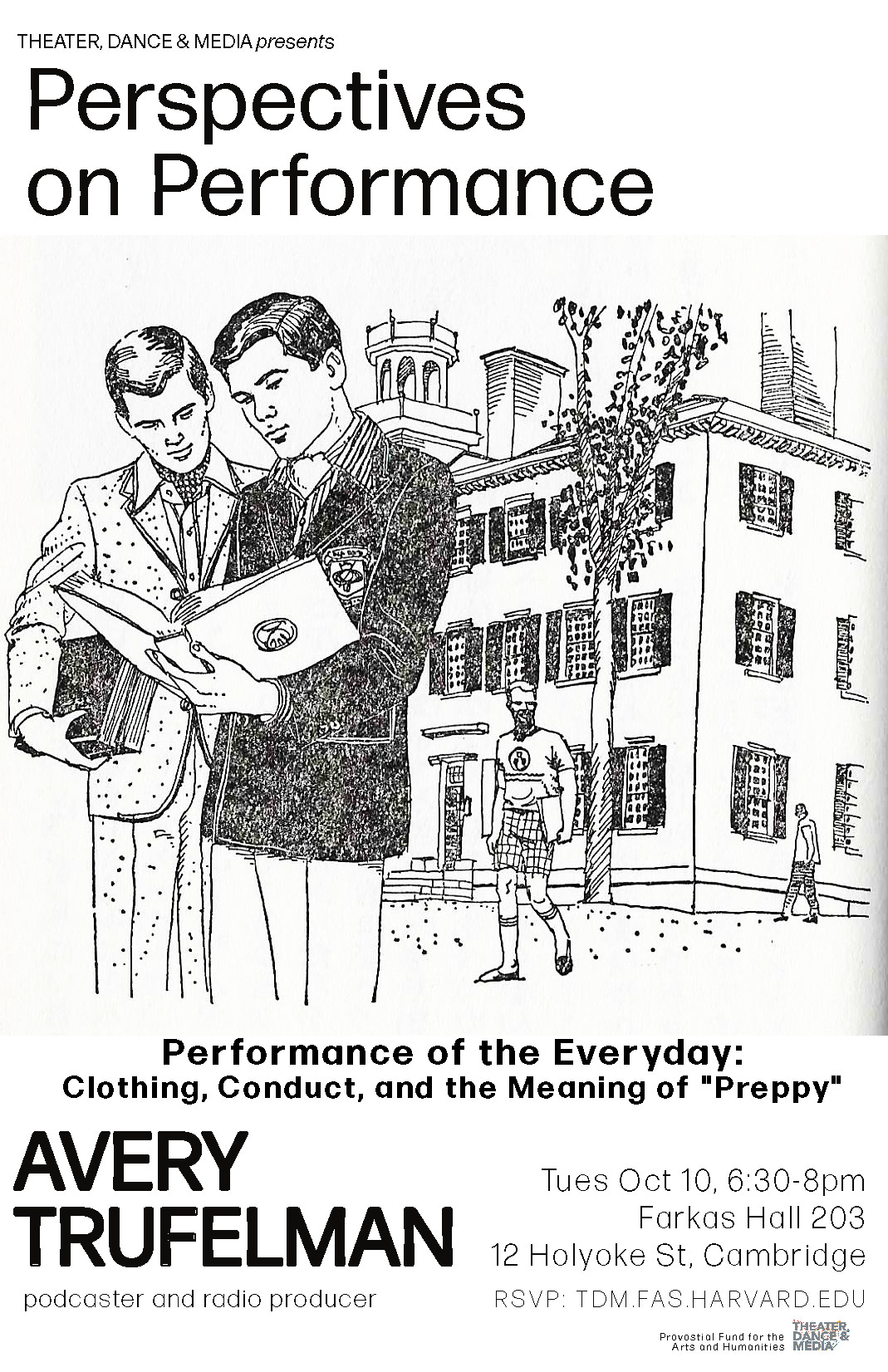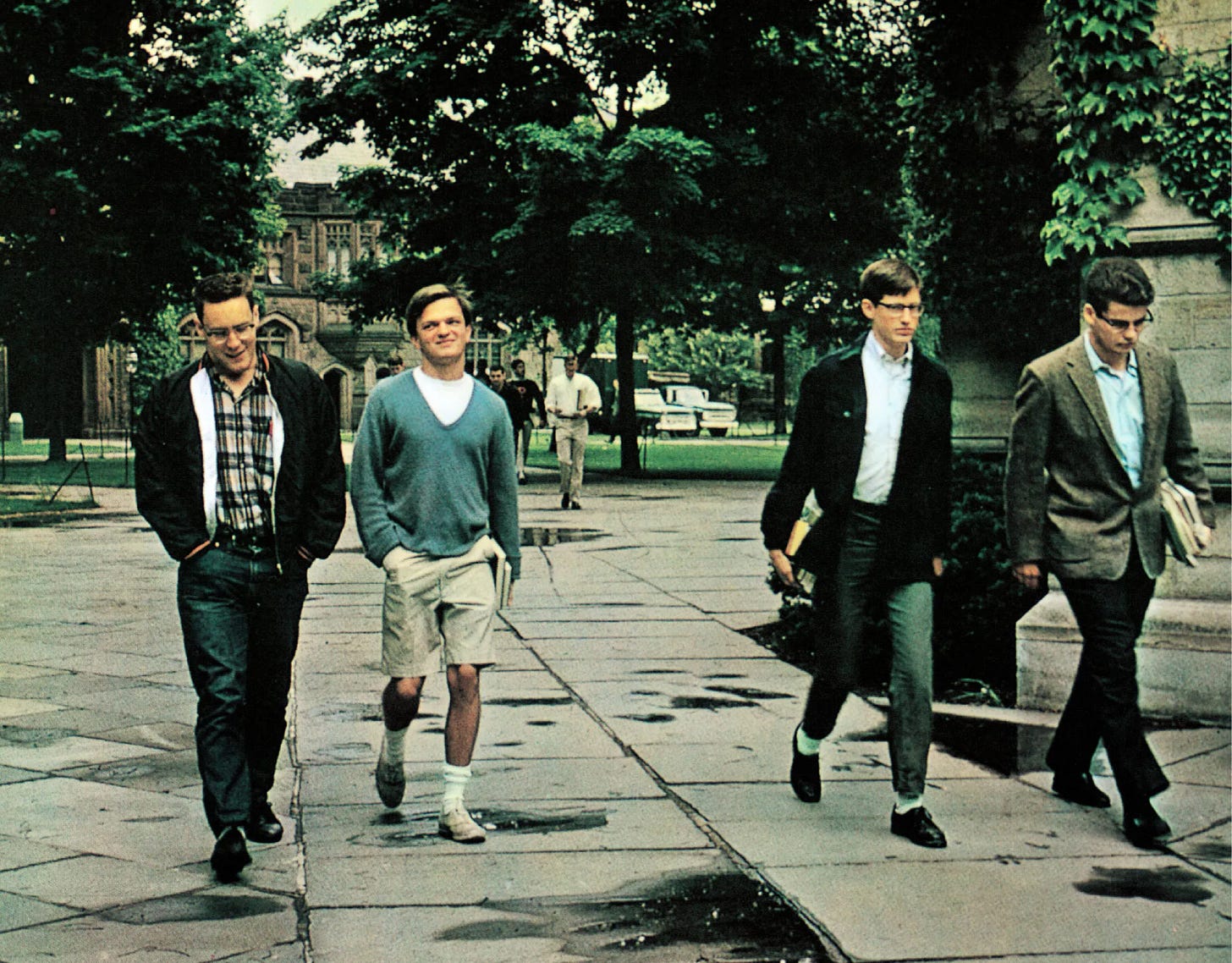Yes, the whole “Men think about the Roman empire” moment is probably past its sell-by-date. But I’m picking it up to explore a thought I’d had weeks before that meme colonized every corner of the discourse: the thought being that Ivy Style is the Roman Empire.
I’d first had the notion after reading a piece last month by Jason Diamond at his newsletter, The Melt, on his exhaustion with the endless “prep is back” narrative that sweeps media like clockwork every 10 years or so. I left a half-joking, half-serious comment comparing the various prep revivals to the Roman Empire and its supposed successors.
I found myself thinking of it again last week, when I attended a talk given by Avery Trufelman at Harvard dubbed “Performance of the Everyday: Clothing, Conduct, and the Meaning of Preppy.” The third season of Avery’s excellent podcast, Articles of Interest, was focused on Ivy style, and in the talk she delivered a condensed version of its thesis: that for all the talk of its rise-fall-and-rise, Ivy style will be with us forever because its core tenets—oxford shirts, chinos, blazers, etc—are now canonized in culture as “normal” clothes.
In the Q&A after, I asked Avery whether it was even possible for another aesthetic to dethrone Ivy, as the monoculture that could once influence the way we dressed by films or “moments” has been blown to smithereens by internet-age atomization.
Which got me thinking of the whole Roman Empire comparison again. Speaking as a deeply weird kid who used to bring Osprey books about the fall of Constantinople to school in the third grade, I’ve long been fascinated by just how long-lived a life the Roman Empire had after is supposed end-date in 476.
Aside from the Byzantine Empire, which could pretty justly claim to be its direct successor and lasted for almost another thousand years, nearly every other imperial power that got its hands on a big chunk of Europe since has tried to play at Roman Empire. Charlemagne, Napoleon, Mussolini—all these guys were explicitly pulling from the Roman legacy to give their regimes legitimacy. Even folks who weren’t having themselves crowned Holy Roman Emperor were borrowing from the imperial lingua franca: think of how “Kaiser” and “Tsar” each derive from “Caesar,” or on the republican front, how much America’s system of democracy with its white-columned buildings full of senators self consciously apes the Roman Republic.
Which is to say, that in the Western World, the Roman Empire (and if you’re going the democratic route, its precursor republic) is viewed as the stand-in for “empire" generally. For more than a millenia years after its fall, it remains the de facto model of the whole empire business. Historians have made the case that this is because it managed something no other regime has since pulled off: uniting the whole of Western Europe under a single state.
Here’s where clothes come back in. As Avery points out in her podcast and her talk, Ivy style clothing—broadly defined—was adopted by nearly the whole of the American population, from G.I. Bill scholars to jazz musicians, New England blue bloods to Black civil rights marchers. And the accessible, comfortable and all-around democratic dress code that is Ivy was adopted by other nations en masse, to the point that it could be considered the greatest visual legacy of America’s late-20th century hegemony.
For reasons laid out by W. David Marx in his excellent book Status & Culture, I’m skeptical that we’ll again experience monocultural “moments” that may effect how we dress, such as how the arrival of Love Story in 1970 was purported to kickstart an interest in preppy clothing after the look’s late ‘60s doldrums, or how the publication of The Official Preppy Handbook in 1980 jumpstarted a decade of teens in candy-colored Lacoste shirts and yuppies in repp ties.
So what we’re left with, at a time when any give fashion website is suddenly posting about “coastal grandmother summer,” “obamacore” or another aesthetic that is maybe a prank and will be forgotten in a matter of weeks, is the lasting sartorial foundation that the empire of Ivy Style bequeathed us.
And much as Rome’s various successor states had differing levels of legitimacy to their claims of continuity—the Byzantines were the the eastern half of the empire that didn’t fall, Charlemagne was crowned “Emperor of the Romans” by the pope in Rome, and the Holy Roman Empire… just kind of had the word “Roman” in it —Ivy’s own revival “eras” and the successor brands that drove them differ from what was understood as Ivy prior to its 1967 “fall” (if we’re going by the dates used in Christian Chensvold’s authoritative essay on the subject at Ivy-Style.com).
If one might think of “golden age” retailers like J. Press, Brooks Brothers and The Andover Shop as the empire itself—all organically Ivy, before there was a romanticized past of the look to play with—we could think of Ralph Lauren as Charlemagne: an ostensible outsider (a Jewish kid from The Bronx/a Frankish King from modern-day Belgium) who emerged after the fall to pick up the pieces and consciously recreate it in their own image alongside other influences and signifiers.
Now, lest this all get too pedantic and eggheady (I just really wanted to say that Ralph Lauren is Charlemagne), I’ll skip forward to argue that we’re in Ivy’s Holy Roman Empire period. When looking to the brands that lead the current revival— Rowing Blazers, Aimé Leon Dore, Drake’s and Noah—there’s plenty that reads as Ivy or preppy: oxford shirts, rugbys, waxed jackets, etc.
But other influences disparate from Ivy’s original iteration (a point also made by Jason in his essay), particularly streetwear, percolate through each to the point that they’ve managed to create their own distinct aesthetics. Think of the tailored-topcoat-and-New Balances swag of ALD to the preppy post-modernism of Rowing Blazers to the prep-school-drop-out-skater-look of Noah.
Much as Voltaire famously quipped that “The Holy Roman Empire is neither Holy, nor Roman,” similar objections could be made to any of these labels. But just as it’s nearly impossible to conceive of Western history in the absence of the Roman Empire, it’s difficult to imagine any of these zeitgeisty brands without the existence of Ivy style and its eternal canon.
And if I’m right, the “Ivy is back” narrative we’ll continue to churn long after we’re gone, too.
Cut, Make and Trim
There’s not a great detail to report on in my own writing elsewhere this week, save for the ‘Ol “Best New Pieces of Menswear” round up I put together each week at Robb Report.
Baracuta has been on an absolute collab tear this fall. One that particularly caught my eye (and received a place in the aforementioned round up) is the label’s link-up with Barbour, which produced a waxed cotton jacket called the Clayton Wax that has nine (!) pockets.
I’ve found that the older I get, the more I rely on/demand pockets from outerwear. For one thing, it allows me to stash my wallet, pen, sunglasses, headphones, etc in a place other than my pants (once you stop putting everything in your pant pockets, you can’t go back). And after becoming a father this summer, pockets are better appreciated than ever: I now assign one pocket on any layer I wear as the designated “pacifier pocket” for the day’s duration.









Also became a father a few months ago and constantly have been throwing things in my coat pockets now. And, I’d consider myself as someone who thinks about ivy style everyday. 😅